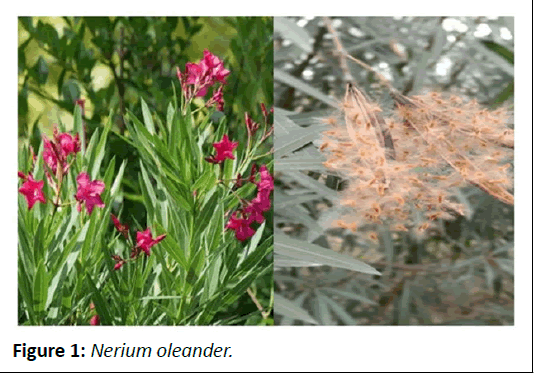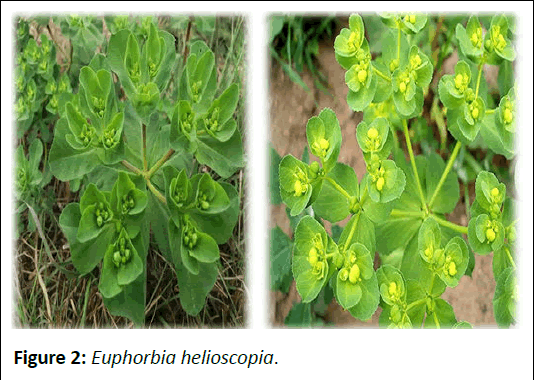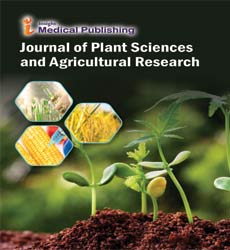Medicinal Importance of Local Plants and Shrubs, Present in Local Area of District Mardan Pakistan (Nerium oleander and Euphorbia helioscopia)
Sultan Shah*
Department of Organic Chemistry, Government Post Graduate College, Mardan 23200, Pakistan
*Corresponding Author:
- Sultan Shah*
Department of Organic Chemistry, Government Post Graduate College, Mardan 23200, Pakistan
E-mail: sultanchemist1@gmail.com
Received date: October 16, 2023, Manuscript No. IPJPSAR-23-18008; Editor assigned date: October 18, 2023, PreQC No. IPJPSAR-23-18008 (PQ); Reviewed date: November 01, 2023, QC No. IPJPSAR-23-18008; Revised date: January 09, 2025, Manuscript No. IPJPSAR-23-18008 (R); Published date: January 16, 2025, DOI: 10.36648/ipjpsar.9.1.169
Citation: Shah S (2025) Medicinal Importance of Local Plants and Shrubs, Present in Local Area of District Mardan Pakistan (Nerium oleander and Euphorbia helioscopia). J Plant Sci Agri Res Vol:9 No:1
Abstract
Medicinal properties have a very wide range of medicinal properties and can be used almost for any kind of treatment. The plants extracted drugs are very effective and thus therefore its medicinal value is very high. Long time ago the traditional treatment of different types of diseases was based on the medicines which were extracted from various plants having medicinal compounds. Medicinally active plants are available anywhere around us but it needs to study their hidden activities in order to make the use of plants for the welfare of human beings. A lot of medicinal plants are present in district Mardan having varieties of antimicrobial and other diseases curing properties.
Keeping the above views in mind in this research work we will discuss some important medicinal plants present in local area of district Mardan Pakistan. The aim of this research work is only to give authentic information about medicinal plants of Mardan district to its citizens.
Keywords
Medicinal properties; Plants; Antimicrobial; Treatment
Introduction
Nerium oleander (commonly known as oleander or in Pushto language it is called Ganderay) is a widely cultivated ornamental plant that has been used traditionally for its medicinal properties. It is evergreen plant of the world having dark green leaves and flowers of various colors (pink, red, orange, white and yellow) [1].
Nerium oleander is present in large scale on Mardan ring road site (territory of Mardan forest division Pakistan) and also cultivated in hotels, restaurants, hospitals and other public places for beauty purposes.
This plant is very toxic in nature due to presence of some poisonous compounds but in spite of toxicity it has the following medicinal importance.
Description
Medicinal activities
Nerium oleander: Nerium oleander has been broadly read up for therapeutic purposes for assortment of diseases. Nerium oleander leaves remove altogether influences on hematological and histopathological boundary because of its poisonousness. Endeavors should be applied to refine different compound parts from remove with no irritation as this plant is used in society medication with restricted restorative files. Seeing that, its utilization is dangerous and ought to be warily investigated [2].
The leaves and the blossoms are cardiotonic, diaphoretic, diuretic, anticancer, antibacterial, antifungal, and expectorant. Nerium oleander has additionally been utilized in the therapy of malignant growth the blossoms, leaves, leaf juice or plastic, bark and roots have been utilized against corns, moles, dangerous ulcers, carcinoma, ulcerating or hard cancers [3].
Furthermore this plant is likewise a wellspring of making best colors, since it has normal cellulose strands which are the essential units of a color [4].
Nerium oleander L, as a matter of fact. is a significant plant. Which has a ton utilizes however one ought to mindful of movements of every sort. Nerium oleander L. is a little evergreen tree with 2-5 m in level and dispersed in various topographical and biological spots. In Bengali the normal name is 'Karabi'. This plant is started in the Mediterranean area and Indo-Pakistan subcontinent. Nerium oleander is a dry season open minded plant and has a place with the Family Apocynaceae. The leaves are 5 cm to 20 cm long, sharpen or intense, in practically no time petiolate, slender, with a coriaceus dim green edge.
Blossoms are created in terminal bunch around 5 cm in breadth with five petals and various varieties change from lilac, salmon, carmine, profound to pale pink, purple, copper, apricot, orange, white and yellow. The organic product comprises of a limited follicle of 7.5 cm to 17.5 cm long and opens to scatter feathery seeds.
This plant can be engendered by seed and shows extraordinary changeability in seedling populaces. Nerium oleander is generally developed as a fancy plant in tropical, subtropical and mild locales because of its abundant blooming which are enduring alongside their moderate toughness. It is utilized for screens, supporting along thruways, planting along sea shores. Framing appealing little trees by leaving only a couple of stems is capable.
Nerium oleander L. has been accounted for in antiquated texts and old stories for a long time. Its plant parts, for example, blossoms, leaf juice, bark and plastic leaves are utilized for the treatment of microbial and parasitic illnesses. All pieces of the plant are likewise utilized as remedial specialist and have been utilized in legends to treat assortment of sicknesses (Figure 1).
Figure 1: Nerium oleander.
The leaves and bark are utilized as expectorant, heart tonic, diuretic, emetic and diaphoretic. Establishes were bubbled in water and supportive in skin grievances, herpes and furthermore ringworm contamination. Tiny portions of leave juice are utilized in snake and other venomous nibbles. Juice of youthful leaves is viable in the fix of eye illnesses. Root glue is regulated in ulceration, hemorrhoids, different kinds of malignant growth and disease.
The underlying foundations of Nerium oleander had a new cardenolide, 12 β-hydroxy-5 β-carda-8,14,16,20(22)-tetraenolide which showed antibacterial and digoxin like cardiovascular exercises.
The bark, stem, leaves, blossoms and foundations of Nerium oleander have insecticidal and hostile to feedant property against Plutella xylostella.
Euphorbia helioscopia: Euphorbia helioscopia L. is another bush which is extremely plentiful in Mardan neighborhood filled unfortunately in each colder time of year season. This bush is an undesirable item in field development in light of the fact that nobody believe this bush should be filled in their fields. Regardless of this the Euphorbia helioscopia is a society medication involved by Chinese individuals in bygone era [5].
It is a little bush having greenish leaves and little granules like parts present at the highest point of the stem (Figure 2).
Figure 2: Euphorbia helioscopia.
Euphorbia helioscopia is a yearly plant filling in arable land and upset ground. It develops to 10 cm-50 cm tall, with a solitary, erect, bald stem, expanding toward the top. The leaves are oval, broadest close to the tip, 1.5 cm-3 cm long, with a finely toothed edge.
The entire plants of E. helioscopia have been first and foremost kept in the most established and exemplary TCM monograph Shennong Bencaojing and usually utilized as conventional Chinese medication or society prescriptions.
E. helioscopia as society medication has been usually utilized for the overwhelming majority years by nearby populaces around the world. It is professed to have many promising natural exercises, including anti-proliferative, multidrug-obstruction balancing, calming, anthelmintic, antibacterial, antifungal, lipidbringing down, cell reinforcement, and wound mending exercises.
Medicinal and other uses of Euphorbia elioscopia L
The arial part of this shrub contains a type of oil called essential oil which shows the antimicrobial activity which was tested on different strains of bacteria, Staphylococcus aureus, Enterococcus faecalis, Escherichia coli, Shigella dysenteriae and a strain of fungus Candida albicans and give satisfactory results [6].
Further this plant has antimicrobial activities like, antifungal, antitumor, antibacterial, antiviral, cytotoxic activity, wounds healing effect, vasodepressor activity, and antioxidant activity due to presence of some chemicals which are essential for drug synthesis [7].
Conclusion
In summary, medicinal plants offer a broad spectrum of therapeutic benefits and have been integral to traditional medicine for centuries. Despite their widespread availability, the full potential of these plants can only be realized through thorough research into their properties and applications. With its rich variety of medicinal flora, exemplifies this potential, presenting opportunities for enhanced health solutions. This research seeks to illuminate the medicinal wealth of the region, providing residents with reliable information to better appreciate and utilize these natural resources for their health and well-being.
References
- Gilman EF, Watson DG (1994) Nerium oleander: Oleander. Fact Sheet ST-412. Gainesville, Florida. Cooperative Extension Service
- Akhtar T, Sheikh N, Abbasi MH (2014) Clinical and pathological features of Nerium oleander extract toxicosis in wistar rats. BMC 7:1-6
[Crossref] [Google Scholar] [PubMed]
- Batra, Zibbu G, Amla (2010) A review on chemistry and pharmacological activity of Nerium oleander L. J Chem Pharm Res 26:351-358
- Jabli M, Tka N, Ramzi K, Saleh TA (2018) Physicochemical characteristics and dyeing properties of lignin-cellulosic fibers derived from Nerium oleander. J Mol Liq 249:1138-1144
- Zhang W, Guo YW (2006) Chemical studies on the constituents of the Chinese medicinal herb Euphorbia helioscopia L. Chem Pharm Bull 54:1037-1039
[Crossref] [Google Scholar] [PubMed]
- Zhu Q, Jiang ML, Shao F, Ma GQ, Shi Q, et al. (2020) Chemical composition and antimicrobial activity of the essential oil from Euphorbia helioscopia L. Nat Prod Commun 15
- Aslam MS, Choudhary BA, Uzair M, Ijaz AS, Roy SD (2014) A review on phytochemical constituents and pharmacological activities of Euphorbia helioscopia. Indian J Pharm Sci 86
Open Access Journals
- Aquaculture & Veterinary Science
- Chemistry & Chemical Sciences
- Clinical Sciences
- Engineering
- General Science
- Genetics & Molecular Biology
- Health Care & Nursing
- Immunology & Microbiology
- Materials Science
- Mathematics & Physics
- Medical Sciences
- Neurology & Psychiatry
- Oncology & Cancer Science
- Pharmaceutical Sciences


